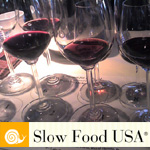
A few days ago, we went to our our first Portuguese wine tasting outside of Portugal (where we visited in June 2006) at New York City’s Lighthouse at Chelsea Piers — a beautiful setting right on the Hudson River. The tasting, called the ViniPortugal 2nd Annual Tasting included more than 400 Portuguese wines from over 50 producers, and since many Portuguese wineries are still family-owned and run, many of the people pouring were the ones who had created the wines or who run the winery, instead of totally unconnected distributors. (In fact, a substantial number of the wineries at the event had signs on their tables saying they were “looking for [an] importer,” showing just how difficult it still is to get many Portuguese wines — beyond the ubiquitous port, of course — in this country.) The event was to benefit the Slow Food USA organization at a mere $35 per person.
We had the most impressive wines of the evening at a fairly basic Portuguese wine seminar led by Michael Weiss, the chair of wine studies at the Culinary Institute of America in Hyde Park and the co-author of “Exploring Wine.” We sampled six reds from around the country, including a delicious Sousao from Casa Santos Lima (Estramadura, 2004) that tasted of black cherry candy (it smelled like the coating on a candy apple) and retails for around $20, and a phenomenal blend of six grapes from the Douro region called Quinta do Vale da Dona Maria (2004), a big berry wine with a delicious flavor of cinnamon, which sells for around $50. We also enjoyed the 2004 Trincadeira from Cortes de Cima (Alentejo, 2004), which had a “dusty strawberry” flavor with nutty caramel at the finish. Yum!
If you’ve never heard of these grapes before (Sousao? Trincaderia?), that’s because there are more than 200 grape varieties indigenous to Portugal. The most common (which you may have never heard of, either) is Touriga Nacional, one of the main grapes in Port (which can be made from a blend of dozens of grapes) and in many red-wine blends from the Douro Valley, a beautiful region of steep vineyards sloping down to the river, as well as the Dao region south of the Douro.
Though we also tasted some sub-par wines at this event, the good Portuguese wines (at least the red ones) tend to be fairly bold, fruity, and flavorful, and relatively inexpensive compared to varietals from other European countries. Now we just need to search out more of them here in NYC!


